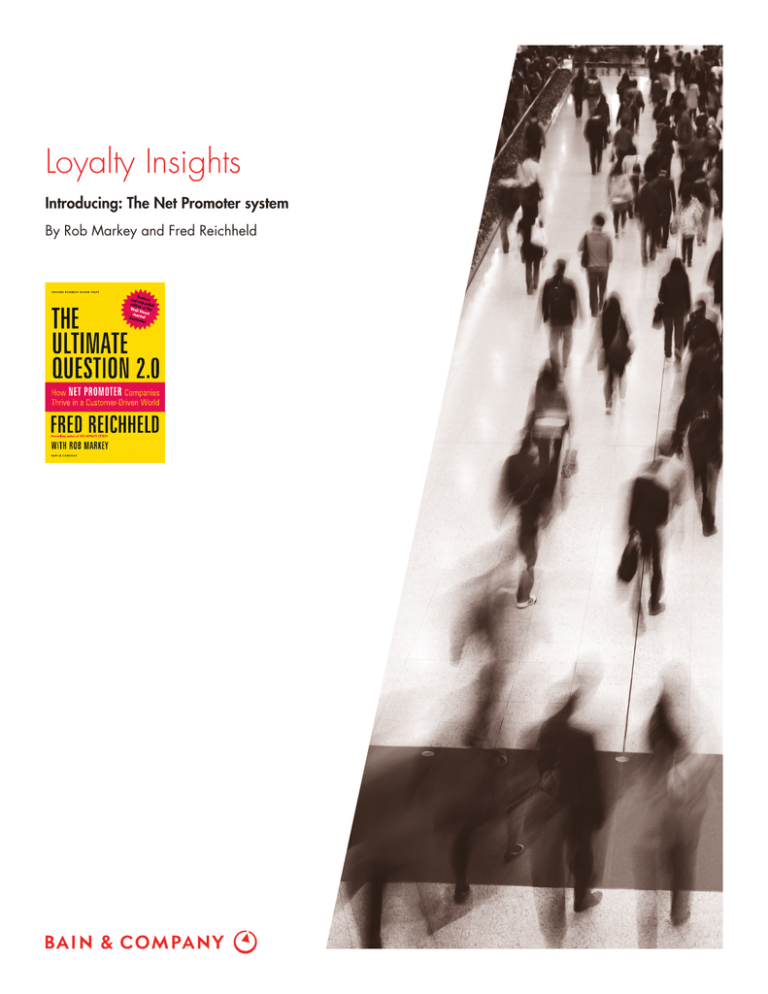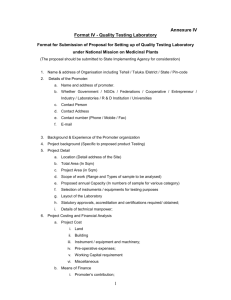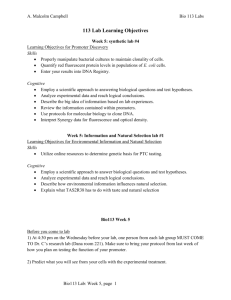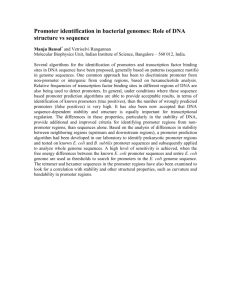
Loyalty Insights
Introducing: The Net Promoter system
By Rob Markey and Fred Reichheld
Fred Reichheld and Rob Markey are authors of the bestseller The Ultimate
Question 2.0: How Net Promoter Companies Thrive in a Customer-Driven World.
Markey is a partner and director in Bain & Company’s New York office and leads
the firm’s Global Customer Strategy and Marketing practice. Reichheld is a
Fellow at Bain & Company. He is the bestselling author of three other books on
loyalty published by Harvard Business Review Press, including The Loyalty Effect,
Loyalty Rules! and The Ultimate Question, as well as numerous articles published
in Harvard Business Review.
Copyright © 2011 Bain & Company, Inc. All rights reserved.
Content: Global Editorial
Layout: Global Design
Introducing: The Net Promoter system
In 2004, the financial services firm Charles Schwab was struggling. Costs were spinning out of control, and the
stock price had plummeted from $40 to just $6. Yet just four years later, Schwab had regained its position as an
industry leader, and its stock price had tripled. A key part of the turnaround: Schwab’s Net Promoter® system, which
helped the company provide world-class service while living up to the customer-focused beliefs that are at the heart
of its strategy. “The beauty of Net Promoter,” says CEO Walt Bettinger, “is that it helps to simplify complex issues
and helps people to make the right decisions. [It] makes people ask themselves: Is this the right thing to do for our
customer, and is it economically appropriate for the firm?”
Rackspace is a young, entrepreneurial company in the fiercely competitive cloud computing and managed hosting
business. It has grown rapidly since its founding in 1998. By 2011, its revenue run rate exceeded $1 billion and
annual growth topped 30 percent. What distinguishes Rackspace from competitors, says CEO Lanham Napier, is
the “Fanatical Support” it offers customers, and the process the company uses to measure and manage Fanatical
Support is the Net Promoter system. “The goal of Fanatical Support is to create customers who are promoters,”
says Napier. “Promoters recommend us to their friends, becoming an extension of our salesforce. Customers who
are promoters are also more profitable, staying with us longer and buying more of our services…. The creation of
loyal promoters not only reduces customer acquisition costs, it improves retention rates and inspires our Rackers
[employees]. We have witnessed these results firsthand.”
Several years ago, American Express CEO Ken Chenault came to believe that his company’s service quality was
not what it should be. Service had become “a backoffice cost center, focused on reducing expenses and executing
transactions,” remembers Jim Bush, the executive Chenault appointed to lead the company’s service organization.
“We were effective and efficient… but we were missing an opportunity to establish bonds with [our customers] and
build more meaningful relationships.” Bush initiated a series of measures to improve service quality and improve
the environment for its service employees. One of the key elements of his approach: launching a Net Promoter
system, known internally as Recommend to a Friend. In just three years, American Express saw a significant increase
in customer satisfaction scores, greater efficiency and service margins, and 50 percent lower employee attrition in
its US service centers.
By now, most executives are familiar with Net Promoter
scores, a method of measuring customers’ loyalty by sorting them into promoters, passives and detractors (see
the sidebar, “Calculating your Net Promoter score”).
But what is the Net Promoter system that has helped
these three companies and many others reach—or remain
in—the top ranks of their industries?
substantial, as Schwab and the others found. Loyal,
passionate customers stay longer, spend more, contribute
suggestions and sing your company’s praises to friends
and colleagues. Loyal, passionate employees love working for you, come up with new ideas and go the extra
mile to delight customers. That’s why loyalty correlates
so strongly with sustainable, profitable organic growth.
On average, an industry’s loyalty leader grows more
than twice as fast as its competitors.
A Net Promoter system is a management philosophy,
a way of running a business. Net Promoter companies
commit to specific processes and systems that help
everyone focus on earning the passionate loyalty of both
customers and employees. The business payoffs are
Financial benefits aren’t the only reason for implementing
a Net Promoter system. Unlike conventional accounting,
which often tempts companies to chase short-term profits
1
Introducing: The Net Promoter system
Calculating your Net Promoter score
The Net Promoter system begins with scores from customer surveys: On a scale of 0 to 10, how likely would you
be to recommend this company (or this product) to friends and colleagues? Ratings of 9 or 10 indicate promoters;
7 and 8, passives; and 0 through 6, detractors. The Net Promoter score is simply the percentage of promoters
minus the percentage of detractors
(see chart below).
Net Promoter score—a simple calculation
How likely is it you would recommend us to a friend?
Extremely likely
10
Not at all likely
9
8
% −
7
6
% =
5
4
3
2
1
0
Net Promoter® score (NPS®)
at the expense of loyalty and even of ethics, the Net
Promoter approach requires—and inspires—a company
to do the right thing by its customers and employees.
It is the business equivalent of the Golden Rule: Treat
others as you would have them treat you. Judging by the
idealistic statements in many companies’ annual reports,
most CEOs are like Bettinger, Napier and Chenault:
They want their companies to grow by enriching the lives
of customers and employees. What they have lacked,
until now, is a system that builds that goal into their
companies’ everyday operations.
Regularly sort their customers into three simple groups:
promoters, passives and detractors. Ideally, companies
ask just two questions in their surveys: On a zero-to-10
scale, how likely is it that you would recommend us
(or this product or service) to a friend or colleague? and
What is the primary reason for your score?
Customers’ responses to the first question allow you to
classify them as promoters (9–10), passives (7–8) and
detractors (0–6). The responses also enable you to create
a Net Promoter score (NPS®), which is simply the percentage of promoters minus the percentage of detractors.
You can analyze this score by business, geographical
region or any other segment, and you can track it from
week to week to see how your loyalty-building efforts
are working. It’s both your customer balance sheet and
The basics
Boiled down to its essentials, a Net Promoter system has
just three requirements. Net Promoter companies:
2
Introducing: The Net Promoter system
your ethical compass. “NPS is the first screen I look at on
my computer when I arrive at the office each morning,”
says Bettinger, Schwab’s CEO. “It provides a litmus test
of how well we are living up to our core values.”
nomically rational ways. So the CEO and CFO need to
understand the vastly different economics of promoters,
passives and detractors and ensure that people in the
organization have the tools for making appropriate
trade-offs. Moreover, a Net Promoter system typically
requires making thoughtful investments, assigning
the most talented leaders to important initiatives and
adjusting incentives and organizational structures to
facilitate cooperation among departments and functions.
Finally, a Net Promoter system is likely to require significant investments in IT systems, training and the
like. Only an organization’s leaders can commit the
necessary resources.
Develop processes for short-cycle, closed-loop feedback,
learning, recovery and action. The “why” question is even
more important than the score itself. It helps companies
understand what they are doing right and what they are
doing wrong. It enables them to begin the process of
discovering the root cause of the customer’s experience—
the deeper causes beneath the customer’s description—
and then to take action to improve that experience.
“Closing the loop” involves sharing feedback from a
customer—as soon as possible after it is received—with
the employees most responsible for creating that customer’s experience. The relevant employees may be an
account team, specific sales or service representatives
and supervisors, or the product designers, engineers,
pricing executives and others who help shape a customer’s
experience with the company. Closing the loop also involves contacting customers whose feedback merits
follow-up, so that you can probe deeper into their experience, remedy individual problems where possible and
begin to address systemic issues. Of course, closing the
loop is also an excellent way to find out what sorts of
experiences are wowing customers and turning them
into promoters, so you can deliver those more often.
The simplicity of the Net Promoter score sometimes
creates the misperception that it is all about one question and the resulting score. But the leaders of great
companies, such as Schwab, Rackspace and American
Express, understand that the score is just the beginning—
the catalyst. It is the full system that creates the conditions for real change and improvement.
Elements of the system
Implementing a Net Promoter system involves at least
eight essential elements (see Figure 1). Future articles
in this series will examine these elements in depth,
showing how companies have dealt with the challenges
and how they have built robust processes and practices
in each area. The following summarizes some of the
tasks involved:
Make it a top priority to earn the enthusiastic loyalty of
customers and employees. That is, create more promoters
and fewer detractors. This is the job of the company’s
leadership. The most effective leaders regularly demonstrate their own commitment to earning customer and
employee loyalty, and they expect a comparable level of
commitment from others. This doesn’t typically happen
unless the leaders have concluded that earning customer
and employee loyalty is a top strategic priority—that
getting customers to buy more, stay longer and tell their
friends is one of the primary ways the company will
deliver great financial and strategic results.
1. Accurate scorekeeping. Over time, companies find
that they must develop, test and fine-tune their sampling and survey techniques so that everyone in the
organization feels complete confidence in both the individual customer classifications and the organization’s
Net Promoter scores.
2. Loyalty economics. Determining the differing lifetime value of promoters, passives and detractors can
help you gauge the value of investments in improving
the customer experience.
Leadership commitment is essential partly because the
system is always a balancing act. Employees naturally
want to delight customers, but they must do so in eco-
3. Root-cause searches. To track down the root cause of
an individual customer’s experience, Net Promoter
3
Introducing: The Net Promoter system
companies ask themselves, What about this customer,
this situation, our marketing, our products or our operations produced the given result? This is not a question that can be farmed out to a market research firm.
IT investments to integrate Net Promoter processes
into their broader operating systems.
8. Commitment and communication. Leaders find they
must not only commit to the Net Promoter system,
they must constantly communicate to the entire organization the importance of the system and the values
that underlie it.
4. Closed-loop procedures. Companies need to develop
practical, consistent methods for sharing feedback with
employees and contacting customers to learn more
about their experiences.
Implementing a Net Promoter system isn’t easy, and it
isn’t for everybody. The Net Promoter approach defines
the cultural values and core economics that affect every
aspect of a company’s business system and competitive
strategy. The most successful companies work hard on
all eight elements, and they try hard to live up to the
Golden Rule values that are the system’s foundation.
5. Learning. Employees must be able to experiment with
what works best for customers. The organization as a
whole needs systems for discovering improvement
opportunities in products, policies and procedures.
6. Action. To create more promoters, companies have
to resolve individual issues, help employees solve problems or “wow” customers on their own, address systemic
issues and improve products and services.
But when you do it right—as Charles Schwab, Rackspace and American Express have discovered—you
leave the competition in the dust.
7. Robust support systems. Large, complex organizations
that run on enterprise software often require significant
Figure 1: The Net Promoter processes
Solid analytics
1
2
3
Reliable metric
Loyalty economics
Root cause
Sort customers,
understand competitive position
Support highquality
costbenefit estimates
Data and processes to
draw insights that unlock action
Prioritized improvements; persistent cultural values; daily action
4
6
5
Closed loop
Learning
Action
Enhance relationships through
true dialogue
Coaching, training,
experimentation
Individual, team,
function, enterprise
Frontline activation
7
8
Robust operational infrastructure
Leadership and communication
4
Bain’s business is helping make companies more valuable.
Founded in 1973 on the principle that consultants must measure their success in terms of their clients’ financial
results, Bain works with top management teams to beat competitors and generate substantial, lasting financial
impact. Our clients have historically outperformed the stock market by 4:1.
Who we work with
Our clients are typically bold, ambitious business leaders. They have the talent, the will and the open-mindedness
required to succeed. They are not satisfied with the status quo.
What we do
We help companies find where to make their money, make more of it faster and sustain its growth longer. We
help management make the big decisions: on strategy, operations, technology, mergers and acquisitions and
organization. Where appropriate, we work with them to make it happen.
How we do it
We realize that helping an organization change requires more than just a recommendation. So we try to put
ourselves in our clients’ shoes and focus on practical actions.
For more information, please visit www.netpromotersystem.com
For more information about Bain & Company, please visit www.bain.com






![2. Promoter – if applicable [2]](http://s3.studylib.net/store/data/007765802_2-78af5a536ba980fb6ded167217f5a2cf-300x300.png)

